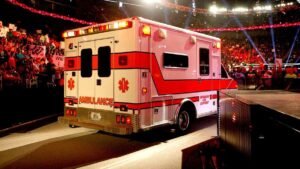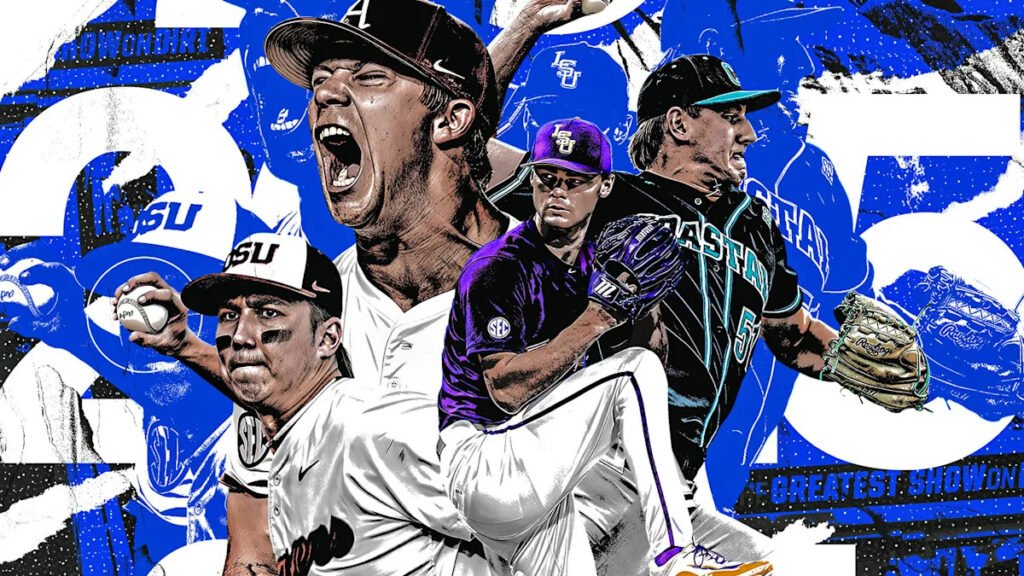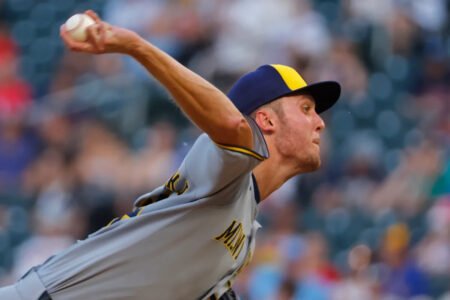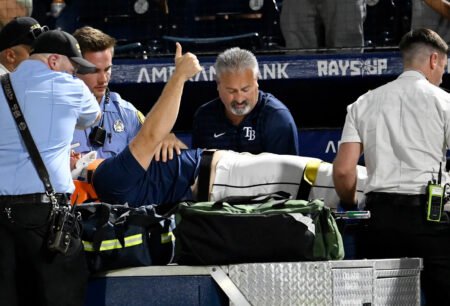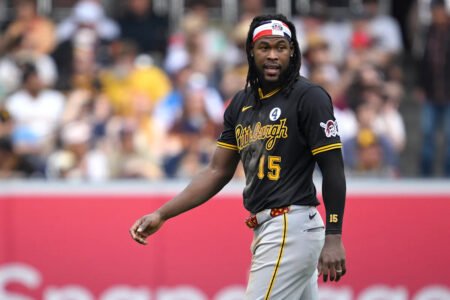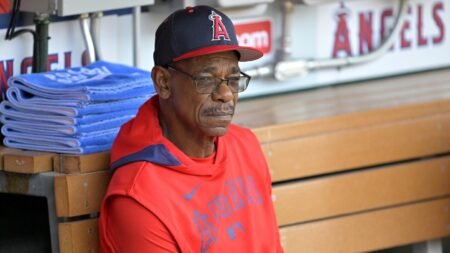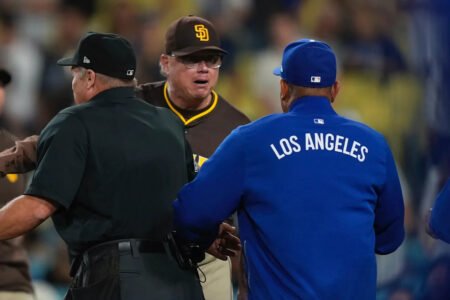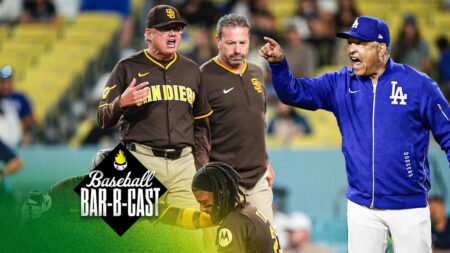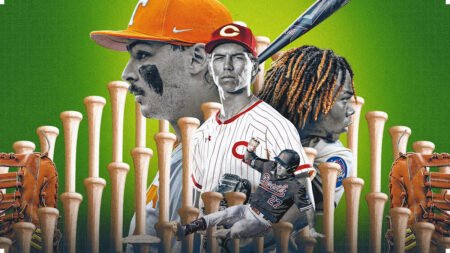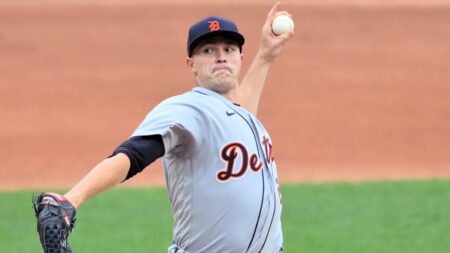The Men’s College World Series final, a scintillating, best-of-three showdown between Coastal Carolina and LSU, gets rolling on Saturday. I just got back from a four-day stretch in Omaha, where I saw seven games featuring seven different teams.
Here are my thoughts on some of the most impressive draft prospects I got eyes on.
1. Aiva Arquette, SS, Oregon State
When Cal Ripken is the physical comparison for a shortstop, you know you’re dealing with something unique. Arquette is long and lean, kind of like Alec Bohm or a shorter James Wood, except the Oregon State shortstop moves like a gazelle. It’s an even taller version of young Carlos Correa, but the defensive fluidity that Arquette showcases despite his 6-foot-5 string-bean-ness is remarkable. One evaluator compared it to how Spurs big man Victor Wembanyama had a late teen growth spurt, so he knows how to handle the basketball.
Advertisement
Arquette made one play in the CWS that was simply beautiful. Some people think he’ll have to move to third, but I’m bullish about him sticking at the game’s most important infield spot.
At the dish, Arquette turned in a magnificent junior season, hitting 19 long balls to go with a .354 average and a 1.115 OPS. There are legitimate concerns about his chase rate and how his long levers might make it harder for him to catch up with pro-level velocity, but the offensive ceiling here is impressive, as Arquette showcased with this absolute laser beam against Louisville on Tuesday.
Most evaluators have Arquette pegged as the top college bat on the board. He won’t get past the top 10 picks.
2. Gage Wood, SP, Arkansas
Wood’s final start as a college pitcher was potentially the single greatest outing in college baseball history: A 19-strikeout no-hitter in a College World Series elimination game. That performance captured headlines, but Wood, on the injured list from Feb. 23 until April 18, was already shooting up draft boards.
Advertisement
He’s undersized but incredibly physical, and his fastball has the potential to be downright special. During the no-hitter, Wood’s fastball sat between 95 and 97 mph with plus carry from a low release point. The best version of that type of heater is Spencer Strider.
Some evaluators think Wood, given his smaller stature and lack of a reliable third pitch, will eventually move to the bullpen. But if he can stick as a starter, there’s something Strider-y about his effective two-pitch mix. Wood, a country kid from the Arkansas backwoods, also proved himself to be a supreme competitor in Omaha. He’ll get taken in the first round.
Aiva Arquette, Gage Wood, Kade Anderson and Jacob Morrison left a lasting impression with their performances in Omaha. (Joseph Raines/Yahoo Sports)
(Joseph Raines/Yahoo Sports)
3. Caden Bodine, C, Coastal Carolina
Bodine has been the leader and best player on a Coastal Carolina team that has won 26 games in a row and is now just two wins away from a national championship. As a pitch-receiver, the New Jersey high school product is about as advanced as a college catcher can be. He has a sophisticated understanding of pitch framing and the physical ability to steal strikes in all parts of the zone. Bodine also gets plaudits for his laser arm and leadership qualities. Defensively, this is what a future Gold Glove catcher looks like.
Advertisement
Offensively, it’s a weirder assortment of tools. Bodine, a switch-hitter, launched only five home runs this season, despite playing in Coastal Carolina’s historically offense-friendly park. Yet the overall slash line of .326/.459/.473 was still awesome, particularly for a catcher. That’s because Bodine has plus, maybe even plus-plus, contact ability and feel to hit. One evaluator I spoke with had Bodine ranked as the No. 1 college position player in the class. Altogether, it’s a fascinating, unusual profile, but Bodine is a surefire first-round pick who shouldn’t get past the Phillies at No. 26.
4. Wehiwa Aloy, SS, Arkansas
Aloy was one of the season’s more remarkable stories. He, alongside his brother Kuhio, propelled the Razorbacks to Omaha while turning Fayetteville, Arkansas, into an unlikely outpost of Hawaiian culture. Along the way, Wehiwa cracked 21 homers and won SEC player of the year. And while he showed well offensively in Omaha — this backside blast was particularly sweet — I’m actually lower on Aloy now than before I saw him live.
The raw juice, particularly to the opposite field, is awesome, but there’s a lot of whiff and chase here for a player that I think is probably a third baseman instead of a shortstop. Aloy has a strong, only-gonna-get-stronger upper half. And while that enables his light-tower power, it also makes him a top-heavy defender at shortstop. That said, I think he has a chance to be pretty good at the hot corner, considering his rocket arm. If he stays at shortstop, the ceiling is Willy Adames with a worse glove: high power, low average, lots of strikeouts and elite makeup that helps everything play up.
5. Kade Anderson, SP, LSU
Unfortunately, Anderson had already thrown by the time I touched down in Nebraska, but the video of his 7-inning, 7-strikeout, 1-run performance against Arkansas tells the story: The southpaw is widely regarded as the top college arm in this class. He has four pitches — fastball, slider, curveball, changeup — that grade out at average or above. The standouts are the fastball, which is comfortably in the mid-90s, and the wipeout slider.
Scouts also love Anderson’s fluidity and athleticism. The ceiling here is a touch lower than some of the other first-round arms in this class, such as high schooler Seth Hernandez or Tennessee lefty Liam Doyle, but Anderson looks like a guaranteed big-league starter. Another fantastic outing in the CWS finals — he’s set to start Game 1 on Saturday — could push him all the way up to the No. 1 pick.
6. Brendan Summerhill, OF, Arizona
Summerhill’s Wildcats were eliminated by the time I arrived in Omaha, so I didn’t get to see him play, but scouts like his combo of athleticism, hit tool and power projection. He didn’t hit for much juice this season, but evaluators generally think Summerhill’s 6-foot-3 frame will grow into more power. He’s another likely first-rounder.
7. Zack Root, SP, Arkansas
Root was up to 99 mph in the super regional against Tennessee, but the southpaw typically sits in the mid-90s. He’s got a long, loopy, high-70s breaker in the Kershaw style (not that good, of course), but his most important pitch is a rapidly improving changeup that allows him to get opposite-handed hitters out. Expect his name to be called anywhere between the comp rounds and the third round.
8. Charles Davalan, OF, Arkansas
Built kind of like Corbin Carroll, Davalan’s profile is somewhere on the scale between Sal Frelick and Jarren Duran. Unfortunately, you probably know his name because he dropped the line drive that allowed LSU to come back and reach the finals. But this guy is a grinder, an old-school scout favorite, with a fiery engine and impressive physicality for somebody his size (5-foot-9). His early pull-side blast in the super regional against Tennessee’s Liam Doyle was the type of in-box move that makes you believe in a player.
Advertisement
It’s also worth noting that Davalan, who transferred to Arkansas after a year at Florida Gulf Coast, is originally from the Montreal area and thus hasn’t been facing high-level arms for that long. I’m pretty in on this dude and think he’ll carve out a nice big-league career as an undersized corner outfielder with some punch.
9. Jacob Morrison, SP, Coastal Carolina
You might’ve missed Morrison’s dominant MCWS start, considering he took the mound mere minutes after the Rafael Devers trade rocked the baseball world. But the very large Coastal righty was brilliant against Oregon State, tossing 7 2/3 innings with no walks, seven strikeouts and just one earned run.
Advertisement
At a marionette-y, herky-jerky 6-foot-8, Morrison reminds me a bit, from a movement standpoint, of Baltimore’s Felix Bautista. The fastball isn’t nearly that special, but Morrison is a sensational competitor who should make the most of his stuff. He was one of college baseball’s best arms this year — 2.08 ERA in 104 innings — and he’s rising up draft boards based on his MCWS showing. He’ll start Game 2 of the championship series and should be drafted in the first three rounds.
10. Jared Jones, 1B, LSU
Since a horrible 0-for-5 with five strikeouts in Game 1 of the MCWS, Jones has been a force. He has clobbered two homers so far in the tournament, and he walked off Arkansas with an RBI laser in that dramatic semifinal game.
But as a pro prospect, I’m out on Jones. Known lovingly as “Bear” because of his enormous, 6-foot-4, 245-pound frame, Jones has been able to physically overwhelm opposing pitchers during his college career. Unfortunately, pro ball is flush with these types of players, and I’m not exactly sure what Jones’ separator is. I don’t love his adaptability in the box, and I think he’s a butcher at first. Maybe he turns into Pete Alonso — another clunky, hulking SEC slugger — but I’d let another team take that risk.
A few quick thoughts on two future draftees
Roch Cholowsky, SS, UCLA
The current favorite to go first overall next year, Cholowsky turned down millions as a high schooler in the 2023 draft to attend UCLA. And he has been a superstar since the second he stepped foot on campus. The son of a pro scout, Cholowky is very mature for his age, as a player and as a leader. He’s a stupendous defender at short, with a glove that comfortably rates as plus. Keep an eye on this guy.
Dax Whitney, SP, Oregon State
Whitney also turned down a bunch of money (in the 2024 draft) to play college ball. The Idaho high school product has a very deceptive windup with a special, high-ride fastball and a big, overhand curve. He’s a potential 1-1 guy for the 2027 MLB Draft.
Read the full article here
